
Can Police Torture be History in Tunisia?
TUNESS organized with the kind support of the Columbia Society of International Law (CSIL) a round table discussion on the topic of police torture in Tunisia. We’re honored to have three distinguished guest speakers; Ms. Tamara Alrifai, Advocacy and Communications Director, the Middle East/North Africa Division, Human Rights Watch, Mr. Bassam Bouguerra co-founder of the NGO “Tunisian Institutional reform” and Mr. Sami Ben Gharbia, Co-founder of Nawaat and Tunileaks. Our guests are expected to share their respective experiences with cases of torture practices and human rights violations in today’s Tunisia and will provide us with concrete proposals to reform the police system.
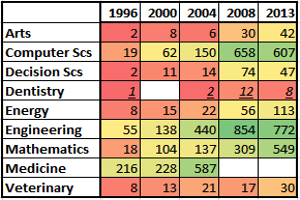
Demystifying the Scientific publications in Tunisia
In this Chart of the Week, we shed light on the metrics of scientific publications in Tunisia to understand its dynamics and trace its patterns. Tunisia ranks 59th worldwide with 44,798 scientific publications. Many international organizations have developed ranking systems such as the H-index, which takes into account factors like publications per capita, citable vs. non-citable effects, and more.
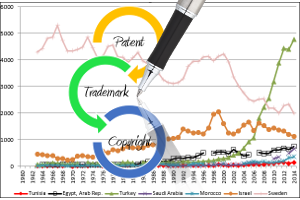
Tunisia Awarded Patents Evolution by the Numbers
There is no doubt that the future success of nations depends on their capacity for innovation. Leading consulting firms like Boston Consulting Group, along with organizations such as the Information Technology & Innovation Foundation (ITIF), have been developing indices to measure innovation and its impact on a country's well-being.

Are we spending enough on R&D to achieve competitive advantage?
Worldwide studies indicate correlation between Research and Development (R&D) and national prosperity. R&D spending could be used as sustainable stimulus to revive an economy. Trends of R&D as a percentage of GDP in TUNISIA and relative to other peer countries are presented in this chart. As reported by the World Bank, from 1996 to 2009 Tunisia R&D spending went from 0.3% to 1.1%. While similar trends were noticed for MENA countries such as Egypt, Morocco, Saudi Arabia, and Turkey, the rates remained noticeably low relative to advanced countries
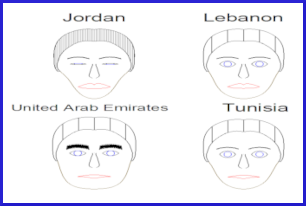
A comparative analysis of the environmental performance in certain MENA countries
This week we study a selection of indicators capturing the Environmental Performance of certain MENA countries. Our goal is review how well countries succeed in reducing environmental stresses on human health and promoting ecosystem vitality and sound natural resource management. We adopt an uncommon method (Chernoff Faces) which has been applied in several other fields. This method named after its creator (Chernoff, Department of Statistics, Stanford University; 1973, Journal of the American Statistical Association 68: 361–368) proposes the use of cartoon-like faces to represent points in k dimensions.
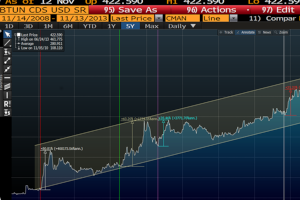
Évolution du risque de crédit de la Tunisie à travers l’historique du CDS sur la BCT
Parmi les indicateurs clés pour analyser la question du risque de défaut de l’état tunisien à honorer ses engagements financiers il existe d’abord les notations souveraines fournies par des agences de rating indépendantes, à titre d’exemple la note de la Tunisie a été abaissée à (BB-) avec perspective négative par Fitch le 31 Octobre 2013, à (B) avec perspective négative par S&P le 16 Aout 2013 et à (Ba2) par Moody’s le 30 Mai 2013, tous dans la catégorie spéculative de chaque système de notation. Malgré ces notes alarmantes, certaines parties et analystes du paysage médiatique tunisien ont demandé de relativiser l’indépendance et la crédibilité de ces agences et crié parfois à la théorie du complot.

Women's employment in Tunisia: high sensitivity to economic crises
TUNESS Chart of the Week (TCW), Monday May 07, 2013
Unemployment is certainly one of the most worrying issues in Tunisia since the revolution. Although many people addressed this topic, few are those who have focused on its impact on women known to be heavier as opposed to men. In the following, we investigate the reasons behind the sensitivity of women's employment to economic shocks. In addition to the revolution of 2011, the Tunisian economy faced few other major events (General Agreement on Tariffs and Trades (GATT ), market liberalization, privatization, the Multi Fiber Arrangement MFA) that affected strongly the sectors employing women.

Labor Productivity in Tunisia: Analysis of Issues and Solutions
This research reviews relevant studies and reports about labor productivity in Tunisia, proposes an overview of issues influencing its efficiency and offers solutions to enhance it. Besides, this research compares some labor productivity metrics in Tunisia and other countries in order to uncover interesting patterns in the past years and suggest explanations to these patterns.

Tunisia’s Lost Five Decades: Government Chronic Failures and Need for Action
This article studies Tunisia’s economic performance in the world stage during the last 50 years. I describe various historical weaknesses and provide policy recommendations in order to alleviate hurdles, break the cycle of chronic mediocrity, and insure the brighter future I believe we are capable of achieving as a nation. I show that Tunisia’s share of world GDP has not changed in the last 50 years, leading to what I refer to as “the Lost Five Decades.”The Tunisian dinar (TND) has been continuously devaluating during this period reducing the purchasing power of every Tunisian.

Forecasting Medium-term Electric Consumption in Tunisia
TUNESS Chart of the Week (TCW), Monday April 08, 2013
Forecasting electric power consumption (EPC) is a crucial and essential activity to gauge electricity generation. The lack of a precise picture of the future may lead to over-capacity or shortages in power that can cause unexpectedly high costs. The attempts conducted to achieve such prediction could be classified into three types of forecasting: short-term (few minutes to few hours), medium-term (few months to few years), and long-term (5 to 25 years in the future).
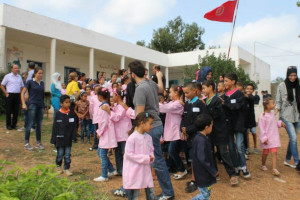
Solidarity with Ghar Wenkel Children 2013/2014
Many children in Tunisia drop out of school at a very young age because of the lack of resources, low income and poor school transportation. According to statistics from the Ministry of Education of Tunisia, 40% of local schools are rural schools. School children aged 6 to 12 years are forced to walk daily on average 1 to 9 miles. Annually, a staggering 70,000 pupils drop out of school due to many factors (e.g., poverty, family issues, long way to travel, difficult geographic conditions, ignorance of school value, non-availability of public transportation, etc.). In 2012 alone, 100,000 pupils dropped out of school across the country mainly in the disadvantaged areas. Ghar Wenkel School (Bizerte) is among many rural schools in Tunisia that did not get the attention it deserved from the government for improvement.
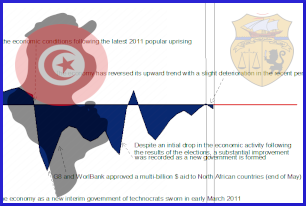
TUN-SEI (NEW Monthly Index of the State of the Economy in Tunisia)
(20/05/2013)
The Tun-Sei index is a new index developed exclusively in-house and published every month by TUNESS Research Team to provide the latest update on the state of the economy in Tunisia. This Index is constructed based on highly relevant (seasonally adjusted) economic indicators (i.e., Industrial Production, Exports, Bank Loans and International Reserves). This is the first attempt to construct a composite index of the state of the economy in Tunisia which could be used to signal any turning point (e.g., peaks and troughs) in the business cycle. The identified four benchmark indicators used in the model provide valuable information about the current position of the economic activity within the business cycles in Tunisia. The selected indicators cover real sector, financial sector, trade sector and foreign exchange market.




